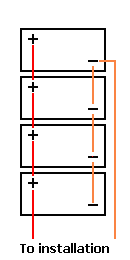what_barnacles
Guru
In the short haul refit thread the following like was provided for some guidance in balancing batteries for power draw. SmartGauge Electronics - Interconnecting multiple batteries to form one larger bank
I dont see where the author determined that the batteries in method 2 are out of balance. I'm hoping someone can point out to me where I am missing the imbalance.
Starting from the bottom and counting "short links" for each battery to get out of the bank I see...
Pos. side, Neg. side, Total
0 3 3
1 2 3
2 1 3
3 0 3
Since the current path for each battery is from the neg. terminal thru the load and back to the pos. terminal, all batteries see the same number of "short links" so the current draw should be equal for all 4 batteries.
Right?
Method 2 reposted for the sake of discussion...




